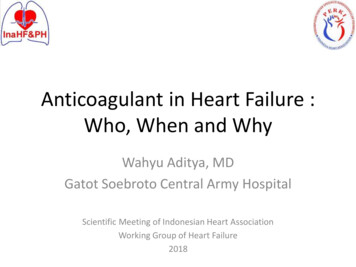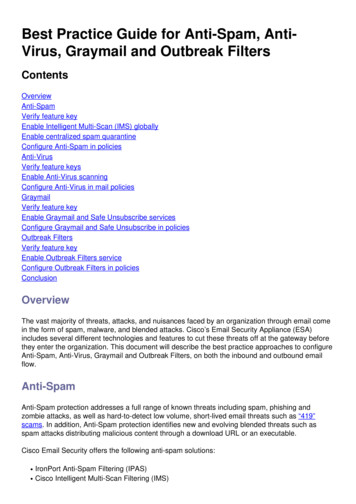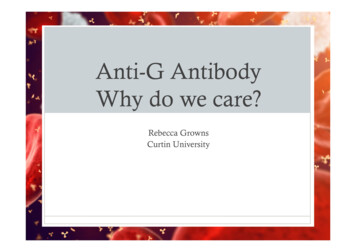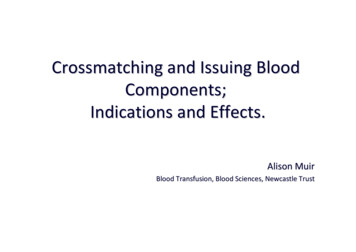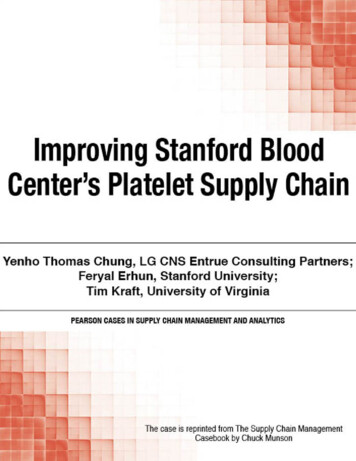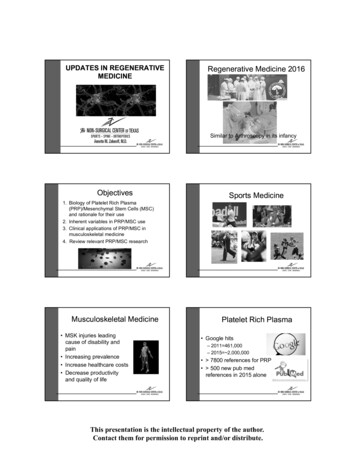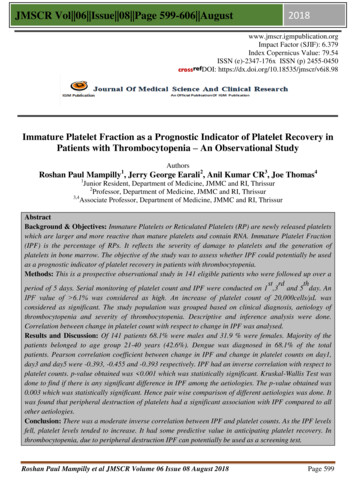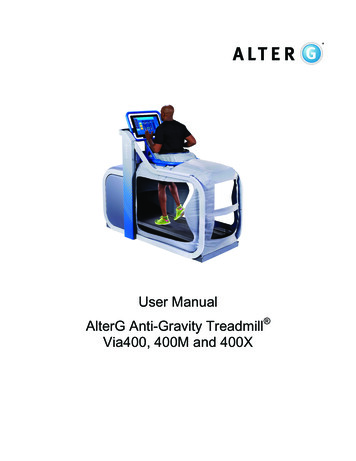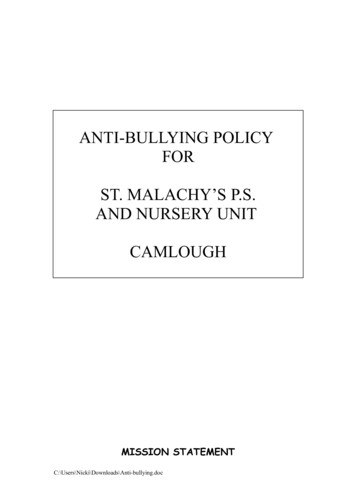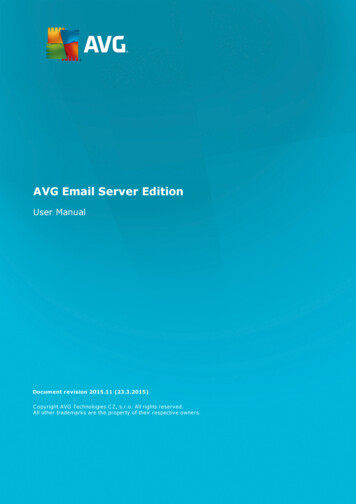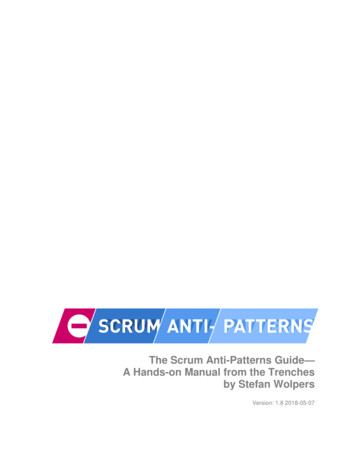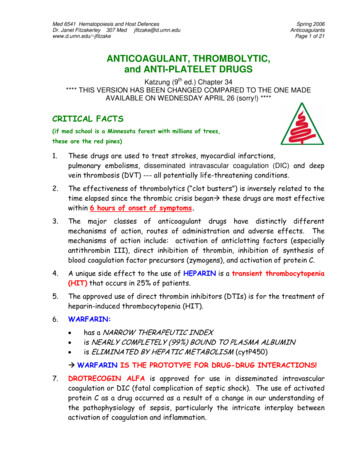
Transcription
Med 6541 Hematopoiesis and Host DefencesDr. Janet Fitzakerley 307 Med jfitzake@d.umn.eduwww.d.umn.edu/ jfitzakeSpring 2006AnticoagulantsPage 1 of 21ANTICOAGULANT, THROMBOLYTIC,and ANTI-PLATELET DRUGSKatzung (9th ed.) Chapter 34**** THIS VERSION HAS BEEN CHANGED COMPARED TO THE ONE MADEAVAILABLE ON WEDNESDAY APRIL 26 (sorry!) ****CRITICAL FACTS(if med school is a Minnesota forest with millions of trees,these are the red pines)1.These drugs are used to treat strokes, myocardial infarctions,pulmonary embolisms, disseminated intravascular coagulation (DIC) and deepvein thrombosis (DVT) --- all potentially life-threatening conditions.2.The effectiveness of thrombolytics (“clot busters”) is inversely related to thetime elapsed since the thrombic crisis beganÆ these drugs are most effectivewithin 6 hours of onset of symptoms.3.The major classes of anticoagulant drugs have distinctly differentmechanisms of action, routes of administration and adverse effects. Themechanisms of action include: activation of anticlotting factors (especiallyantithrombin III), direct inhibition of thrombin, inhibition of synthesis ofblood coagulation factor precursors (zymogens), and activation of protein C.4.A unique side effect to the use of HEPARIN is a transient thrombocytopenia(HIT) that occurs in 25% of patients.5.The approved use of direct thrombin inhibitors (DTIs) is for the treatment ofheparin-induced thrombocytopenia (HIT).6.WARFARIN: has a NARROW THERAPEUTIC INDEXis NEARLY COMPLETELY (99%) BOUND TO PLASMA ALBUMINis ELIMINATED BY HEPATIC METABOLISM (cytP450)Æ WARFARIN IS THE PROTOTYPE FOR DRUG-DRUG INTERACTIONS!7.DROTRECOGIN ALFA is approved for use in disseminated intravascularcoagulation or DIC (fatal complication of septic shock). The use of activatedprotein C as a drug occurred as a result of a change in our understanding ofthe pathophysiology of sepsis, particularly the intricate interplay betweenactivation of coagulation and inflammation.
Med 6541 Hematopoiesis and Host DefencesDr. Janet Fitzakerley 307 Med jfitzake@d.umn.eduwww.d.umn.edu/ jfitzakeSpring 2006AnticoagulantsPage 2 of 21DRUGS YOU NEED TO KNOW:ANTICOAGULANTSARGATROBANBIVALIRUDIN (Angiomax)DALTEPARIN (Fragmin)DROTRECOGIN ALFA (ACTIVATEDPROTEIN C) (Xigris)ENOXAPARIN (Lovenox)FONDAPARINUXHEPARIN (Calciparine, Hepathrom,Lipo-Hepin, Liquaemin, Panheprin)HIRUDIN (Desirudin)4-HYDROXYCOUMARIN (Coumadin)LEPIRUDIN (Refludan)WARFARIN (Athrombin-K, Panwarfin)XIMELAGATRAN (Exanta)ANTIDOTESPHYTONADIONE (Vitamin K1)PROTAMINE SULFATEAMINOCAPROIC ACID (EACA) (generic,Amicar) (in bleeding disorders handout!)THROMBOLYTICSANISTREPLASE (APSAC; Eminase)STREPTOKINASE (Streptase, Kabikinase)TISSUE PLASMINOGENACTIVATORS (tPAs): ALTEPLASE(Activase), RETEPLASE (Retavase),TENECTEPLASE (TNKase)UROKINASE (Abbokinase)ANTIPLATELET DRUGSABCIXIMAB (Centocor)ACETYLSALICYLIC ACID (Aspirin)CLOPIDOGREL (Plavix)DIPYRIDAMOLE (Persantine)EPTIFIBATIDE (Integrilin)TICLOPIDINE (Ticlid)TIROFIBAN (Aggrastat)IMPORTANT MATERIAL FROM OTHER LECTURES:1.2.Principles of pharmacokinetics and pharmacodynamics, esp. therapeutic index,drug metabolism, the cytochrome P450 system (Dr. Knych, Principles), and typesof biological variability (Dr. Eisenberg, Principles).Coagulation and thrombosis (Drs. Krafts and Prohaska, Hematopoiesis).OBJECTIVES:1.2.Be able to diagram the coagulation and fibrinolytic pathways and the interactionof protein C with those pathways. Define how different classes of anticoagulantand fibrinolytic drugs interact with specific clotting factors and naturally occurringanticoagulants in the context of these pathways.Be able to describe the biochemical mechanisms of action, therapeutic uses,contraindications and adverse effects of the specific anticoagulant and fibrinolyticagents listed above. Know the properties of agents that can reverse the actionsof heparin and the oral anticoagulants.
Med 6541 Hematopoiesis and Host DefencesDr. Janet Fitzakerley 307 Med jfitzake@d.umn.eduwww.d.umn.edu/ jfitzakeSpring 2006AnticoagulantsPage 3 of 213.Describe the empirical rationale for thrombolytic therapy, its limitations and theagents that are currently approved for this purpose. Be able to identify both thecommon and the distinguishing characteristics of thrombolytic agents.4.Compare and contrast:a.heparin and low molecular weight heparinsb.heparin and warfarinwith respect to mechanism of action, administration, time to onset of activity,method of monitoring, antidotes and use during pregnancy.5.6.Understand why particular disease states and co-administration of other drugscan alter the efficacy and side effects of warfarin. Be able to describe specificpharmacokinetic and pharmacodynamic principles governing the interactions ofwarfarin with specific drugs listed in the main section of the handout. Be able touse cytochrome P450 interaction tables to identify the interactions of other drugswith both R- and S-warfarin.Know the specifics of the anti-coagulant, fibrinolytic and anti-inflammatory actionsof drotrecogin alfa.THERAPEUTIC STRATEGIESThese drugs are used to treat strokes, tedintravascular coagulation (DIC) and deep vein thrombosis(DVT) --- all potentially life-threatening conditions. Degrade fibrinogen/fibrin (fibrinolytic agents)GOAL: eliminate formed clots Inhibit clotting mechanism (anticoagulants)GOAL: prevent progression of thrombosis Interfere either with platelet adhesion and/or aggregation (antiplatelet drugs)GOAL: prevent initial clot formation
Med 6541 Hematopoiesis and Host DefencesDr. Janet Fitzakerley 307 Med jfitzake@d.umn.eduwww.d.umn.edu/ jfitzakeSpring 2006AnticoagulantsPage 4 of 21
Med 6541 Hematopoiesis and Host DefencesDr. Janet Fitzakerley 307 Med jfitzake@d.umn.eduwww.d.umn.edu/ jfitzakeSpring 2006AnticoagulantsPage 5 of 21THROMBOLYTIC DRUGStPAs: ALTEPLASE, RETEPLASE, TENECTEPLASE,ANISTREPLASE, STREPTOKINASE, UROKINASECommon Features dissolve existing lifethreatening thrombi activate plasminogen toThe effectiveness of thrombolytics isinversely related to the time elapsedsince the thrombic crisis began Æthese drugs are most effective within6 hours of onset of symptomsplasmin Æ hydrolysis of fibrin and several other coagulation factors plasmin formed inside a thrombus is protected from plasma antiplasmins short activation times, and short half-lives recommended for patients with:orecent acute MI (selection of patients is critical!!! Some can be harmed)oextensive pulmonary emboliosevere deep vein thrombosisothromboembolic stroke (tPAs only)Common Contraindications/Precautions cause BLEEDING (particularly hemorrhagic stroke) – can be antagonized byAMINOCAPROIC ACID (for tPAs) or APROTININ (for STREPTOKINASE)oinhibitory control system can be overwhelmed producing a systemic lytic stateÆ not for use in:1.recent surgery (10 days)2.GI bleeding (3 months)3.active bleeding or hemorrhagicdisorder4. previous cerebrovascular accidentor active intracranial process5. history of hypertension(diastolic 110 mmHg)6. pregnancy7. aortic dissection8. acute pericarditisthrombolytic therapy is expensive (particularly tPAs)
Med 6541 Hematopoiesis and Host DefencesDr. Janet Fitzakerley 307 Med jfitzake@d.umn.eduwww.d.umn.edu/ jfitzake1.Spring 2006AnticoagulantsPage 6 of 21ANISTREPLASE, STREPTOKINASEMechanism of Action binds to and induces a conformational change in plasminogen resulting inexposure of the active site and conversion to plasmin (STREPTOKINASE itselfis not intrinsically active) ANISTREPLASE is an inactive complex of STREPTOKINASE and humanlys-plasminogen - more convenient (shorter infusion time) but far moreexpensive with an increased tendency for systemic thrombolysisAdverse Effects 2.may evoke allergic hypersensitivity reactions, fever and anaphylaxisUROKINASEMechanism of Action kidney enzyme that directly converts plasminogen to active plasmin primarily indicated only for patients allergic to STREPTOKINASEAdverse Effects febrile episodes are common but infusion reactions and hypersensitivity(anaphylaxis) are rare3.TISSUE PLASMINOGEN ACTIVATORS (tPAs): ALTEPLASE,RETEPLASE, TENECTEPLASE genetically engineered from human melanoma cellsoALTEPLASE is unmodified human tPAoRETEPLASE has several amino acid sequences deletedoTENECTEPLASE is a recombinant version of human tPA with 3amino acid substitutions
Med 6541 Hematopoiesis and Host DefencesDr. Janet Fitzakerley 307 Med jfitzake@d.umn.eduwww.d.umn.edu/ jfitzakeSpring 2006AnticoagulantsPage 7 of 21Mechanism of Action causes “selective” activation of fibrin-bound plasminogen poor plasminogen activator in the absence of fibrin, i.e., theoretically confinesfibrinolysis to the formed thrombus and decreases systemic activationANTICOAGULANT DRUGSThe major classes of anticoagulant drugs havedistinctly different mechanisms of action,routes of administration and adverse effects.
Med 6541 Hematopoiesis and Host DefencesDr. Janet Fitzakerley 307 Med jfitzake@d.umn.eduwww.d.umn.edu/ jfitzakeSpring 2006AnticoagulantsPage 8 of 21Mechanisms of Action:1.Activation of anticlotting factors (especially antithrombin III) e.g. HEPARIN2.Direct inhibition of thrombin e.g. HIRUDIN3.Inhibition of synthesis of blood coagulation factor precursors (zymogens)e.g. WARFARIN4.Activated Protein C i.e., DROTRECOGIN ALFA1.DRUGS THAT ACTIVATE ANTICLOTTING FACTORS:HEPARIN, DALTEPARIN, ENOXAPARIN, FONDAPARINUXGeneralitiesHEPARIN most commonly given anticoagulant for short term use ( 12 million patients/year) is a complex mixture of mucopolysaccharides isolated from bovine lung or porcine intestine normally found in mast cells - unknown physiologic role strongly acidicDALTEPARIN, ENOXAPARIN low MW fragments of HEPARINFondaparinux synthetic formulation of the key pentasaccharide that appears to be the activecomponent in all heparinsMechanisms of Action1.Bind to antithrombin III, a protease inhibitor that complexes with activatedclotting factors II, IX, X and XI (i.e., heparins are INDIRECT thrombin inhibitors) conformational change in ATIII exposure of ATIII active site more rapid formation of ATIII-protease complexes
Med 6541 Hematopoiesis and Host DefencesDr. Janet Fitzakerley 307 Med jfitzake@d.umn.eduwww.d.umn.edu/ jfitzake 2.Spring 2006AnticoagulantsPage 9 of 21release of HEPARIN; activated clotting factors remain bound to ATIIICoat blood vessel wall (prevents platelet binding or causes permeabilization?)Pharmacokinetics activity is standardized by bioassay must be given IV (not active orally; IM administration causes hematomas) rapid effect (within minutes); instantaneously in vitro metabolized in liver; excreted in urine HEPARIN dose is adjusted to double partial thromboplastin time (monitored by aPTT)DALTEPARIN, ENOXAPARINGreater than heparinLess than heparin Anti-factor Xa activity Inactivation of thrombin (IIa) Bioavailability (SC administration) Platelet inhibition Half-life (decreased dosing) Vascular permeabilization More predictable pharmacology Plasma protein binding(less need for monitoring)Therapeutic Indications for an immediate hypothrombic response:o massive deep-vein thrombosiso pulmonary infarcto post-operative acute MI (except brain, spinal cord or eye)o prior to cardioversion of atrial fibrillation effective anticoagulant in vitroAdverse Effects HEMORRHAGE (esp. hemorrhagic stroke) hypersensitivity
Med 6541 Hematopoiesis and Host DefencesDr. Janet Fitzakerley 307 Med jfitzake@d.umn.eduwww.d.umn.edu/ jfitzake Spring 2006AnticoagulantsPage 10 of 21transient HIT occurs in about25% of the patients during first 5days of treatment – severe HITA unique side effect to theuse of heparin is a transientthrombocytopenia (HIT).occurs in 5% of patientso small % of patients develop antibody-mediated thrombocytopenia that isassociated with thrombosis (paradoxical)o in those patients, HEPARIN should be discontinued, and treatmentinitiated with HIRUDIN or LEPIRUDIN, but not WARFARIN (mayexacerbate the prothrombotic state) prolonged administration of high doses may causeo osteoporosiso progressive reduction in antithrombin III Æ decreased effectiveness,increased clottingo mineralocorticoid deficiencyPROTAMINE SULFATE highly basic peptide that combines with HEPARIN as an ion pair lasts about 2 hours routinely used following cardiac surgery and other vascular procedures excess protamine also has an anticoagulant effect, since it can interact withplatelets, fibrinogen and other plasma proteins anaphylactic reactions can occur - approximately 1% of patients with diabetesmellitus who have received protamine-containing insulin experience anaphylaxis cannot reverse many LMWH!
Med 6541 Hematopoiesis and Host DefencesDr. Janet Fitzakerley 307 Med jfitzake@d.umn.eduwww.d.umn.edu/ jfitzake2.DIRECT THROMBIN INHIBITORS (DTIs):ARGATROBAN,BIVALIRUDIN, HIRUDIN, LEPIRUDIN, XIMELAGATRANMechanism of Action Spring 2006AnticoagulantsPage 11 of 21HIRUDINwasisolatedfromLEPIRUDINoriginallyThe approved use of DTIs is forthe treatment of heparininduced thrombocytopenia (HIT).leech;istherecombinant form; BIVALIRUDIN is a synthetic analogue work by 1) inhibiting fibrin binding to thrombin and 2) interacting with the thrombinactive site Æ inhibiting thrombin activity even in the presence of bound fibrin ARGATROBAN is a synthetic derivative of L-arginine - ARGATROBAN andXIMELAGATRAN bind reversibly to the thrombin active site advantages over HEPARIN:1.inhibition of coagulation via a single mechanism of action2.actions are independent of antithrombin III, which means they can reach andinactivate fibrin-bound thrombin inside clots3.little effect on platelets or bleeding time4.elimination of HIT as a side effect of treatment5.not inactivated by platelet or plasma proteins6.more uniform potency and increased safety7.rebound coagulation after discontinuation of the drug is less likely with directthrombin inhibitorsPharmacokinetics given IV (note: XIMELAGATRAN is first oral agent in this class Æ promoted as areplacement for both WARFARIN and HEPARIN because of its immediateanticoagulant action metabolized by hydrolysis in liver, excreted in urine
Med 6541 Hematopoiesis and Host DefencesDr. Janet Fitzakerley 307 Med jfitzake@d.umn.eduwww.d.umn.edu/ jfitzake Spring 2006AnticoagulantsPage 12 of 21monitored by aPTT – ARGATROBAN causes elevated INRs because of testinterference, making the transition to warfarin difficultAdverse Effects HEMORRHAGE: dose related; increased in patients with renal insufficiency,liver injury, or recent trauma and/or treatment with other anticoagulants3.DRUGS THAT INHIBIT SYNTHESIS OF COAGULATION FACTORPRECURSORS: 4-HYDROXYCOUMARIN, WARFARINMechanism of Action inhibit epoxide hydrase interfere with the synthesis of vitamin K and thusinhibits activation of vitamin K-dependent clottingfactors (II, VII, IX, X) also decreases the activity of protein C (activated bythrombin) – responsible for some side effectsPharmacokineticsWARFARIN: has a NARROW THERAPEUTIC INDEX is NEARLY COMPLETELY (99%) BOUND TO PLASMA ALBUMIN is ELIMINATED BY HEPATIC METABOLISM (cytP450)Æ WARFARIN IS THE PROTOTYPE FOR DRUG-DRUG INTERACTIONS! rapid, complete absorption from GI; peak plasma drug concentration in 1 hr WARFARIN is a racemic mixture of R- and S-forms – S is the active enantiomer S- and R- WARFARIN are metabolized differently; S is metabolized primarily byCYP2C9, and R by CYP1A2, CYP2C19 and CYP3A4 several genes play a role in WARFARIN metabolism:
Med 6541 Hematopoiesis and Host DefencesDr. Janet Fitzakerley 307 Med jfitzake@d.umn.eduwww.d.umn.edu/ jfitzake Spring 2006AnticoagulantsPage 13 of 21polymorphisms in CYP2C9 cause about 30% of patients to be slow metabolizers(causes Ï serum concentrations) polymorphisms in the vitamin K epoxide reductase multiprotein complex (VKOR)can confer resistance (Ð serum concentrations) recent clinical studies show that testing for CYP2C9 polymorphisms allowsphysicians to better predict the appropriate starting dose for WARFARIN, allowingthe achievement of stable blood levels more quickly than the current method of trialand-error dosing defects in the coagulation cascade can also confer resistance to WARFARIN: themost common are: APC resistance (factor V Leiden), protein S deficiency, protein Cdeficiency, antithrombin III deficiency no in vitro effect readily crosses placenta delayed hypothrombic effect (1-3 days); t½ 35 hr, biological t½ 6-6O hrs small daily doses – adjustment of prothrombin time takes 1 weekTherapeutic Indications rodenticides
Med 6541 Hematopoiesis and Host DefencesDr. Janet Fitzakerley 307 Med jfitzake@d.umn.eduwww.d.umn.edu/ jfitzakeSpring 2006AnticoagulantsPage 14 of 21 long-term oral treatment of deep-vein thrombosis for 2-6 months following myocardial infarction atrial fibrillationAdverse Effects HEMORRHAGE flatulence and diarrhea are common decreased protein C causes cutaneous necrosis caused during first weeks oftreatment; rarely can progress to infarction (venous thrombosis) in fatty tissues,intestine and extremities bone defects (chondrodysplasia punctata) and hemorrhagic disorders in terÆ ABSOLUTELY CONTRAINDICATED IN PREGNANCYofpregnancy
Med 6541 Hematopoiesis and Host DefencesDr. Janet Fitzakerley 307 Med jfitzake@d.umn.eduwww.d.umn.edu/ jfitzake Spring 2006AnticoagulantsPage 15 of 21DISEASE STATE and DRUG INTERACTIONSPHARMACOKINETIC ABSORPTION DISTRIBUTION ELIMINATION binding in intestine plasma protein bindingcytP450 inhibitioncytP450 inductionPHARMACODYNAMIC SYNERGISM ANTAGONISM ALTERED VITAMIN K platelet/clotting factor function concentration of clotting factors availability of vitamin K
Med 6541 Hematopoiesis and Host DefencesDr. Janet Fitzakerley 307 Med jfitzake@d.umn.eduwww.d.umn.edu/ jfitzakeDrug InteractionsImportance of Cytochrome P450 IsozymesSpring 2006AnticoagulantsPage 16 of 21
Med 6541 Hematopoiesis and Host DefencesDr. Janet Fitzakerley 307 Med jfitzake@d.umn.eduwww.d.umn.edu/ jfitzakeSpring 2006AnticoagulantsPage 17 of 21ILLUSTRATIVE CASE A 74-year-old woman with insulin-dependent (type 2) diabetes had been takingMETOPROLOL and WARFARIN for atrial fibrillation and AMITRIPTYLINE fordiabetic neuropathy for several years.On the death of her husband, shepresented with symptoms of depression and PAROXETINE was added to hermedication regimen. Three days after the initiation of paroxetine therapy, the woman was brought to theemergency department by her daughter, who had found her asleep at 11 am. Onawakening, the patient complained of dry mouth and dizziness. The ER physician, noting that paroxetine had been added recently, changed thepatient to FLUVOXAMINE, which he thought would be less sedating. Three days later, the patient was still very sedated and dizzy, and complained ofdifficulty urinating.She was again brought to the ER, where bladdercatheterization yielded two liters of dark urine. Her INR was 4.0.“Classic” cytochrome P450 interactions alcohol, barbiturates, cimetidine, fluvoxamine, phenytoinDrugs that ALWAYS Interact with Warfarin aspirin, cimetidine, phenytoinDrugs that are LIKELY to be co-administered with Warfarin (due to co-morbidity,high prescription rate and/or OTC status) By class: other anticoagulants, antiplatelet drugs, analgesics and NSAIDS,sedative-hypnotics, anti-arrhythmics, antibiotics/antifungals, antihyperlipidemics, GIdrugs (esp. antacids), uricosurics (anti-gout), diuretics, thyroid medications Specifically:abciximab, alcohol (acute and chronic), allopurinol, e,cimetidine,ciprofloxacin,clofibrate, erythromycin, fluconazole, gemfibrozil, HEPARIN, HIRUDIN, lovastatin,metronidazole, miconzaole, NSAIDS, phenytoin, phytonadione, sulfonamides,
Med 6541 Hematopoiesis and Host DefencesDr. Janet Fitzakerley 307 Med jfitzake@d.umn.eduwww.d.umn.edu/ jfitzakeSpring 2006AnticoagulantsPage 18 of 21thyroid hormones, trimethoprim-sulfamethoxazoleMany herbal supplements: black cohosh, chamomile, dong quai, feverfew, garlic,ginger, gingko biloba, ginseng (only one that decreases efficacy)Pharmacokinetic INCREASES in EffectInhibition of metabolismAcute rimethoprim-sulfamethoxazoleDecreased Plasma Protein BindingClofibrateGemfibrozilPhenytoin lePharmacokinetic DECREASES in EffectEnzyme InductionCarbamazepineChronic alcoholPhenytoin (ultimately)Decreased absorptionCholestyraminePharmacodynamic INCREASES in EffectDecreased platelet/clotting factor functionAbciximabASAHeparin, Dalteparin, EnoxaparinDecreased availability of vitamin KCephalosporinsHirudin, LepirudinPharmacodynamic DECREASES in EffectIncreased concentrations of clotting factorsDiureticsVitamin K
Med 6541 Hematopoiesis and Host DefencesDr. Janet Fitzakerley 307 Med jfitzake@d.umn.eduwww.d.umn.edu/ jfitzakeSpring 2006AnticoagulantsPage 19 of 21DISEASE STATESINCREASE ANTICOAGULANTEFFICACYDECREASE ANTICOAGULANTEFFICACYBlood dyscrasias2Alcoholism (chronic) 4(hemophilia, von Willebrand’s disease, thrombocytopenia)Diarrhea1Edema2Elevated temperature3Hyperlipemia1Hepatic disease2,4Hereditary ate diet1(esp. vitamin K deficiency)Nephrotic syndrome4Jaundice2Small bowel disease1Steatorrhea11. vitamin K levels1. vitamin K levels2. synthesis/function of clotting2. synthesis/function of clottingfactors and/or plateletsfactors and/or platelets3. clotting factor turnover3. clotting factor turnover4. drug metabolism/elimination4. drug metabolism/elimination* Hereditary resistance to warfarin has been shown to be due to defects in thecoagulation cascade, the most common of which are: APC resistance (factor VLeiden), protein S deficiency, protein C deficiency, antithrombin III deficiencyPHYTONADIONE (Vitamin K1) pharmacodynamic antagonist (not due to disappearance of warfarin, but rather thereestablishment of normal clotting factor activity) – takes 24 hours fresh-frozen plasma or factor IX concentrates are also effective
Med 6541 Hematopoiesis and Host DefencesDr. Janet Fitzakerley 307 Med jfitzake@d.umn.eduwww.d.umn.edu/ jfitzakeSpring 2006AnticoagulantsPage 20 of 214. DROTRECOGIN ALFA (ACTIVATED PROTEIN C)DROTRECOGIN ALFA is approved for use in disseminated intravascularcoagulation or DIC (fatal complication of septic shock). The use ofactivated protein C as a drug occurred as a result of a change in ourunderstanding of the pathophysiology of sepsis, particularly the intricateinterplay between activation of coagulation and inflammation.Mechanism of Action recombinant version of protein C; activated by thrombin; requires Ca2 ,phospholipid and protein S as cofactors anti-coagulant actions:1)destroys activated factors Va and VIIIa, resulting in thrombin formation2)inhibits platelet activation3)suppresses tissue factor expressionfibrinolytic actions1)attenuates thrombin-catalyzed activation of tPA inhibitors2)decreases PAI-1 concentrationsanti-inflammatory actions:1)inhibits synthesis of tumor necrosis factor2)inhibits neutrophil activation3)blocks the release of cytokines from macrophagesTherapeutic Indications decreases relative risk of death by 20% (up to 50% of patients die of sepsis within6 months)Adverse Effects HEMORRHAGE: dose related, no increase in patients with renal or liverinsufficiency
Med 6541 Hematopoiesis and Host DefencesDr. Janet Fitzakerley 307 Med jfitzake@d.umn.eduwww.d.umn.edu/ jfitzakeSpring 2006AnticoagulantsPage 21 of 21ANTIPLATELET DRUGSASA, ABCIXIMAB, CLOPIDOGREL, DIPYRIDAMOLE,EPTIFIBATIDE, TICLOPIDINE, TIROFIBANMechanisms of ActionInhibit platelet adhesion and aggregation by:1.Inhibiting cyclooxygenase: e.g. ASA2.Blocking glycoprotein IIb/IIIa receptor: e.g. ABCIXIMAB, EPTIFIBATIDE3.Inhibiting the binding of fibrinogen to activated platelets: e.g. CLOPIDOGREL,TICLOPIDINE4.Inhibiting cyclic nucleotide phosphodiesterase: e.g. DIPYRIDAMOLE
Med 6541 Hematopoiesis and Host Defences Spring 2006 Dr. Janet Fitzakerley 307 Med jfitzake@d.umn.edu Anticoagulants www.d.umn.edu/ jfitzake Page 6 of 21
